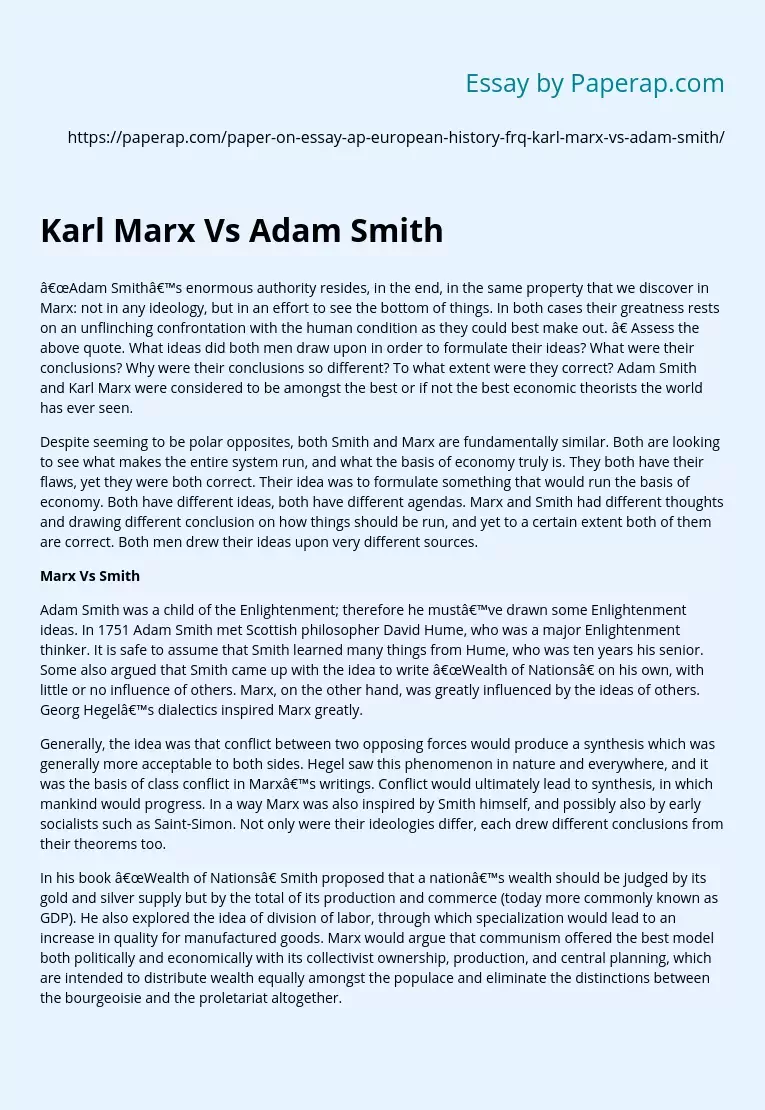Karl Marx Vs Adam Smith
“Adam Smith’s enormous authority resides, in the end, in the same property that we discover in Marx: not in any ideology, but in an effort to see the bottom of things. In both cases their greatness rests on an unflinching confrontation with the human condition as they could best make out. ” Assess the above quote. What ideas did both men draw upon in order to formulate their ideas? What were their conclusions? Why were their conclusions so different? To what extent were they correct? Adam Smith and Karl Marx were considered to be amongst the best or if not the best economic theorists the world has ever seen.
Despite seeming to be polar opposites, both Smith and Marx are fundamentally similar. Both are looking to see what makes the entire system run, and what the basis of economy truly is. They both have their flaws, yet they were both correct. Their idea was to formulate something that would run the basis of economy.
Both have different ideas, both have different agendas. Marx and Smith had different thoughts and drawing different conclusion on how things should be run, and yet to a certain extent both of them are correct. Both men drew their ideas upon very different sources.
Marx Vs Smith
Adam Smith was a child of the Enlightenment; therefore he must’ve drawn some Enlightenment ideas. In 1751 Adam Smith met Scottish philosopher David Hume, who was a major Enlightenment thinker. It is safe to assume that Smith learned many things from Hume, who was ten years his senior.
Some also argued that Smith came up with the idea to write “Wealth of Nations” on his own, with little or no influence of others. Marx, on the other hand, was greatly influenced by the ideas of others. Georg Hegel’s dialectics inspired Marx greatly.
Generally, the idea was that conflict between two opposing forces would produce a synthesis which was generally more acceptable to both sides. Hegel saw this phenomenon in nature and everywhere, and it was the basis of class conflict in Marx’s writings. Conflict would ultimately lead to synthesis, in which mankind would progress. In a way Marx was also inspired by Smith himself, and possibly also by early socialists such as Saint-Simon. Not only were their ideologies differ, each drew different conclusions from their theorems too.
In his book “Wealth of Nations” Smith proposed that a nation’s wealth should be judged by its gold and silver supply but by the total of its production and commerce (today more commonly known as GDP). He also explored the idea of division of labor, through which specialization would lead to an increase in quality for manufactured goods. Marx would argue that communism offered the best model both politically and economically with its collectivist ownership, production, and central planning, which are intended to distribute wealth equally amongst the populace and eliminate the distinctions between the bourgeoisie and the proletariat altogether.
He reasoned that workers would be exploited by capitalists (or bourgeoisie), for the capitalist system basically means that the rich would get richer and the poor would get poorer. Furthermore, the bourgeoisie is always in a better position to negotiate a low wage for the proletariats. One of his theories, the labor theory of value, claims that the value of a good or service is directly connected to the amount of labor required for its production. So, in effect the two theories and conclusion were very different. The very difference in ideology is what set the two apart.
While Adam Smith contended that the most ideal economic system is capitalism, Marx believed that capitalism leads to greed and inequality. Karl Marx is more of a revolutionary; Adam Smith was more to reforms rather than a full-scale revolution, as he valued order and stability more rather than freedom from oppression. Karl Marx saw class struggle, while Adam Smith saw special interests that were often at odds with the general public interest. Also, Smith did not put the spotlight on the land holdings or the riches of the aristocracy like Marx did.
They also differed on the method of production of goods and services and distribution of resources. While Adam Smith’s envisioned ideal society would not distribute resources equitably or eliminate gaping wealth levels between the different classes in a society, Marx’s ideal economy would produce, according to the directives from a central authority, and distribute resources according to the needs of the public. However, despite the disagreements, both Smith and Marx were correct to a certain extent. In a wider perspective, they both wanted a prosperous nation of wealth.
They both also agreed that the workers (proletariats) were crucial for the production of goods. Both of them also recognized that there is a conflict, or at least a wide division, between the working and upper class. Adam Smith also realized that there are basic social classes: land-owners, wage earners, and capitalists. Marx, to a certain extent, also accepted the condition where there are different classes, albeit trying to change the situation. Overall, both of them proposed ideas to change the economy to fit their liking, despite both economists going in a completely different direction altogether.
Karl Marx Vs Adam Smith. (2019, Dec 05). Retrieved from https://paperap.com/paper-on-essay-ap-european-history-frq-karl-marx-vs-adam-smith/

